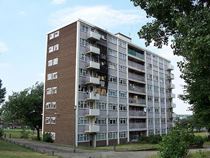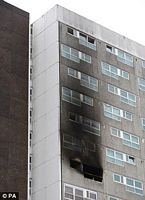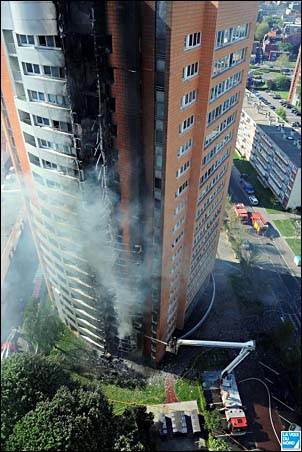Click on Images to enlarge
Carlton Tower, Block 1, Leeds 2006 Pic; Flicr,Good Honest Iago/James W Bell |
Shirley Towers, Hampshire 2011 Pic: PA/Southern Echo |
Al-Tyer, UAE 2011 Pic : Firegeezer.com |
|||
The term "autoexposure" is one that is not often used in the UK. The American Chief Vincent Dunn defined it as "the spread of flames from one floor to the floor above on the outside of the building." It is now more broadly used to descirbe any external vertical fire spread. By far the most common event will be heat and flame spread from a lower window to one above it.
External fire spread in high rise buildings is effected by an opening, either existing or created by structural failure, allowing heat and flames to exhaust out the building and impinge on other parts of the building, usually above. Case study and past events would suggest that if the internal fire separation is intact and operational, the commonest cause of fire spread beyond the flat/apartment of origin, is through external spread.
Also becoming more of an issue is external spread through cladding and insulation products. A common practice in the UK when refurbishing High rise buildings is to clad the outside of the blocks with polystyrene insulation sheets, which are at least 4 inches thick. Then they are covered with mesh and rendered. This gives them compliance with Class 1 Surface Spread of Flame and a low fire propagation to BS 476 Part 6 1989. Unfortunately once this thin render coat fails or is disrupted, it exposes vast quantities of polystyrene. Installation of these insulation systems is a highly skilled process that required fire breaks through the wall surface. The guidance (UK, AD-B and BS8414) generalises that the insulation material should be of "limited combustion" and that the cladding system will not permit excessive spread outside the building. Unfortunately there are already instances in the UK where fire has travelled up the outside of a high rise building via a clad insulation system, in one instance (Glasgow 2009) it traveled 9 storeys.
There are two physical properties of fire at work that will escalate Autoexposure.:
CONVECTION: Products of combustion (Heat, Hot Gasses and Fire) will rise.
THE COANDA EFFECT : Will draw the stream of hot gasses (and flame) back against the building surfaces.

As can be seen above the heat will impinge on the window unit above causing either the frame to weaken and fail (common to uPVC double glazed units) or for the glazing to fail under heat stress.
Some typical External spread incidents
(Click pictures to enlarge)
Glazing failure
Florin Court London: Pic @IanOzsvald 2013 |
Fire spread through external cladding Roubaix-e-la-voix Pic firegeezer.com 2012 |
Frame and Glazing failure
Pic : Marl Harrison, The Seattle Times 2010 |
SPANDREL DISTANCE
In a building with more than one floor, the term spandrel is also used to indicate the space between the top of the window in one story and the sill of the window in the story above. This may be important to Fire fighters as the Spandrel is most often constructed from materials the will offer enhanced fire resistance. Larger spandrel distances can offer better resistance to external spread.
BALCONIES AND PROJECTIONS
In general balconies will slow external fire spread. They reduce the impact of the Coanda effect and effectively create extended vertical and horizontal Spandrel distances.
There are instances of storage on balconies (usually chairs) that have acted as a fuel and have increased external spread. Balconies are usually accesses by side hung or patio doors and these can provide large openings.
Acknowledgement :





